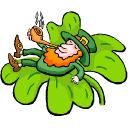There’s more to St. Patrick’s Day than shamrocks, green beer and pinching people.
By Karma Christine Salvato
Staff Writer
Shamrocks, the color green and those curious little creatures called leprechauns are usually the first things that  come to mind when people think of St. Patrick’s Day. Though originally a Catholic holy day, St. Patrick’s Day has evolved into more of a secular holiday. And in America, it has more or less been reduced to a day of wearing green and a night full of partying.
come to mind when people think of St. Patrick’s Day. Though originally a Catholic holy day, St. Patrick’s Day has evolved into more of a secular holiday. And in America, it has more or less been reduced to a day of wearing green and a night full of partying.
“Only recently (within the past 15 years) has Ireland turned St. Patrick’s Day into a Mardi Gras-like party,” said Edward T. O’Donnell, associate professor of history at the College of the Holy Cross in Worcester, Mass., and an expert in the field of Irish-American history.
“For centuries it was a solemn religious holiday and all the pubs were closed,” he said.
Sadly, through the years, the true history of the holiday has become trivialized. It has been lost amid all of the myths, legends and revelry.
“But for the Irish, it’s much more than the leprechauns and green color,” Ninian Mellamphy, an English professor at The University of Western Ontario and an expert on Irish culture noted on the university’s Web site.
“The real significance,” she continued, “is the culture, rich in antiquity and layered with the customs of many different civilizations. Irish memory is very significant, and many Irish plays are centered around this theme — which can be much more interesting than leprechauns, fairy forts and other mythical folklore people have used to explain the oddness of the relics of Ireland’s ancient civilizations.”
St. Patrick’s Day is an Irish holiday that honors St. Patrick, the missionary credited with founding hundreds of churches and converting thousands of people to Christianity. The Irish have observed this day as a religious holiday for thousands of years. St.  Patrick is believed to have died on March 17, around 460 A.D. This day has been commemorated as St. Patrick’s Day ever since.
Patrick is believed to have died on March 17, around 460 A.D. This day has been commemorated as St. Patrick’s Day ever since.
Known as the patron saint of Ireland, although he was not Irish, St. Patrick is one of Christianity’s most widely known figures. But, even with all of his notability, much of his life still is a bit of a mystery.
Born in the latter half of the 4th century A.D., there are differing views about the exact year and place of St. Patrick’s birth. According to one school of opinion, he was born about 390 A.D., while the other school says it is about 373 A.D. Historical sources report that he was born in either Scotland or Roman Britain. And, St. Patrick wasn’t originally St. Patrick — his real name is believed to be Maewyn Succat, later being changed to Patrick after becoming a priest.
At the age of 16, St. Patrick was taken prisoner by a group of Irish raiders who were attacking his family’s estate. They transported him to Ireland where he worked as a shepherd and ended up spending six years in captivity. Lonely and afraid, St. Patrick turned to religion for solace and soon became a devout Christian. It was during that time that he began to have religious visions and dreams. In one dream, he was shown a way to escape from Ireland — by going to the coast and getting on a ship. He walked nearly 200 miles to get to the Irish coast and escaped to Britain.
St. Patrick later reported having another vision of an angel telling him to return to Ireland as a missionary. Not too long after that revelation he began intensive religious training that lasted more than 15 years. After completing his studies he was ordained as a priest and then returned to Ireland to spread the word of God. His journey consisted of a dual mission — to minister to Christians already living in Ireland, and to begin to convert the Irish. St. Patrick is said to have had an unusually captivating personality that helped him to win converts. His ministry lasted about 30 years.
The shamrock, a three-leafed clover, is the national emblem of Ireland and is widely believed to have been used by St. Patrick to illustrate the concept of the Trinity. Also called the “seamroy” by the Celts, the shamrock was a sacred plant in ancient Ireland because it symbolized the rebirth of spring. By the 17th century, the shamrock had become a symbol of emerging Irish nationalism. As the English began to confiscate Irish land and make laws against the use of the Irish language and the practice of Catholicism, many Irish began to wear the shamrock as a symbol of their pride in their heritage and their displeasure with English rule.
 Another popular symbol associated with St. Patrick’s Day is the Leprechaun. The original Irish name for these figures of folklore is “lobaircin,” meaning “small-bodied fellow.” Belief in leprechauns most likely stems from Celtic belief in fairies, tiny men and women who could use their magical powers to serve good or evil.
Another popular symbol associated with St. Patrick’s Day is the Leprechaun. The original Irish name for these figures of folklore is “lobaircin,” meaning “small-bodied fellow.” Belief in leprechauns most likely stems from Celtic belief in fairies, tiny men and women who could use their magical powers to serve good or evil.
“Stop right there, turn around slowly and DROP that picture in your mind of the little guy on the Lucky Charms cereal box,” writes O’Donnell in his book “1001 Things Everyone Should Know About Irish American History.” “That jolly little imp, and his counterparts on greeting cards, pub signs and your Aunt Margaret’s stationary, bears almost no resemblance to the leprechauns of Irish mythology,” he continued. “To borrow a phrase from a long-dead philosopher writing about something entirely different, they were ‘nasty, brutish and short.’ Leprechauns were grumpy, alcoholic, insufferable elves in the employ of Irish fairies. They made shoes for fairies (hence their depiction as cobblers) and guarded their treasure which to the leprechauns’ eternal frustration was revealed occasionally to mortals by a rainbow. Somewhere in the course of the Irish American experience, the leprechaun took on the characteristics of the lovable, but ultimately contemptible, stage Irishman.”
Parades are a big part of St. Patrick’s Day as well but, considering that it was observed as a religious holiday for many years, that was not always the case. The first St. Patrick’s Day parade took place not in Ireland, but in the United States. Irish soldiers serving in the English military marched through New York City on March 17, 1762.
These festivities, for many individuals, revolve more around having fun than in remembering the reason behind the celebration. Ireland used to shut down in observance of the holiday. But, since 1995, the Irish government sanctioned festivals and other events on St. Patrick’s Day as a way to increase tourism and share Ireland with the rest of the world.
March 13, 2003

